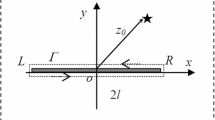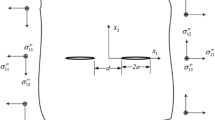Abstract
A non-homogeneous medium with multiple line inclusions is studied. The stiffness of the inclusions considered in this study is infinite. The model established can handle any non-homogeneity (continuous varying material properties or layered structures) and orthotropic in mechanical properties. The problem of rigid line inclusions in homogeneous medium can be considered as a special case of the model. Dependence of the inclusion tip fields on the strain intensity factor is given in closed form. Existence of multiple (parallel) inclusions can significantly reduce the strain intensity at the inclusion tips. However, the collinear inclusions will increase the strain intensity at the inclusion tips.








Similar content being viewed by others
References
Koiter, W.T.: On the diffusion of load from a stiffener into a sheet. Q. J. Mech. Appl. Math. 8, 164–178 (1955)
Ballarini, R.: A rigid line inclusion at a bimaterial interface. Eng. Fract. Mech. 37, 1–5 (1990)
Kerr, G., Melrose, G., Tweed, J.: Antiplane shear of a strip containing a periodic array of rigid line inclusions. Math. Mech. Solids 3, 505–512 (1997)
Tang, R.J., Tao, F.M., Zhang, M.H.: Interaction between a rigid line inclusion and an elastic circular inclusion. Appl. Math. Mech. English Ed. 18, 441–448 (1998)
Jobin, T.M., Ramji, M., Khaderi, S.N.: Numerical evaluation of the interaction of rigid line inclusions using strain intensity factors. Int. J. Mech. Sci. 153, 10–20 (2019)
Bigoni, D., Dal Corso, F., Gei, M.: The stress concentration near a rigid line inclusion in a prestressed, elastic material. Part II Implications on shear band nucleation, growth and energy release rate. J. Mech. Phys. Solids 56, 839–857 (2008)
Corso, F. Dal., Bigoni, D.: The interactions between shear bands and rigid lamellar inclusions in a ductile metal matrix. Proc. R. Soc. A 465, 143–163 (2009)
Dal Corso, F., Bigoni, D., Gei, M.: The stress concentration near a rigid line inclusion in a prestressed, elastic material. Part I Full-field solution and asymptotics. J. Mech. Phys. Solids 56, 815–838 (2018)
Hu, Z.L., Li, X.F.: A rigid line inclusion in an elastic film with surface elasticity. Z. Angew. Math. Phys. 69, 92 (2018)
Hu, Z.L., Yang, Y., Li, X.F.: Singular elastic field induced by a rigid line inclusion in a thin nanoplate with surface elasticity. Int. J. Mech. Sci. 198, 106386 (2021)
Liu, Y.W., Fang, Q.H.: Plane elastic problem on rigid lines along circular inclusion. Appl. Math. Mech. English Ed. 26, 1585–1594 (2005)
Jiang, C.P., Cheung, Y.K.: Antiplane problem of collinear rigid line inclusions in dissimilar media. Eng. Fract. Mech. 52, 907–916 (1995)
Kaczynski, A., Matysiak, S.J.: Stress singularities in a periodically layered composite with a transverse rigid line inclusion. Arch. Appl. Mech. 80, 271–283 (2010)
Liu, Y.W.: Antiplane problems of periodical rigid line inclusions between dissimilar anisotropic materials. Appl. Math. Mech. English Ed. 22, 1149–1154 (2001)
Lee, K.Y., Kwak, S.G.: Determination of stress intensity factors for bimaterial interface stationary rigid line inclusions by boundary element method. Int. J. Fract. 113, 285–294 (2002)
Prasad, P.B.N., Hasebe, N., Wang, X.F., Shirai, Y.: Green’s functions for a bi-material problem with interfacial elliptical rigid inclusion and applications to crack and thin rigid line problems. Int. J. Solids Struct. 42, 1513–1535 (2005)
Gorbatikh, L., Lomov, S.V., Verpoest, I.: Relation between elastic properties and stress intensity factors for composites with rigid-line reinforcements. Int. J. Fract. 161, 205–212 (2010)
Wang, B.L., Han, J.C., Du, S.Y.: Cracks problem for non-homogeneous composite material subjected to dynamic loading. Int. J. Solids Struct. 37, 1251–1274 (2000)
Wang, B.L., Han, J.C., Du, S.Y.: Electroelastic fracture dynamics for multilayered piezoelectric materials under dynamic anti-plane shearing. Int. J. Solids Struct. 37, 5219–5231 (2000)
Wang, B.L., Hu, J.S.: Crack growth behavior and thermal shock resistance of ceramic sandwich structures with an auxetic honeycomb core. Compos. Struct. 260, 113256 (2021)
Gradshteyn, I.S., Ryzhik, I.M.: Tables of Integrals, Series and Products. Academic Press, New York (1965)
Wang, B.L., Han, J.C., Du, S.Y.: Electromechanical behaviour of a finite piezoelectric layer under a flat punch. Int. J. Solids Struct. 45, 6384–6398 (2008)
Nan, H.S., Wang, B.L.: Effect of interface stress on the fracture behavior of a nanoscale linear inclusion along the interface of bimaterials. Int. J. Solids Struct. 51, 4094–4100 (2014)
Erdogan, F., Wu, B.H.: Crack problem in FGM layers under thermal stresses. J. Thermal Stresses 19, 237–265 (1996)
Wang, B.L., Li, J.E.: Fracture behavior and thermal shock resistance analysis of thermoelectric material plates and shells under thermal and electric shocks. Eng. Fract. Mech. 225, 106130 (2000). https://doi.org/10.1016/j.engfracmech.2018.08.024
Wang, P., Wang, B.L., Wang, K.F., Cui, Y.J.: Analysis of inclusion in thermoelectric materials: the thermal stress field and the effect of inclusion on thermoelectric properties. Compos. B 166, 130–138 (2019)
Wang, P., Wang, B.L., Wang, K.F., Hirakata, H., Zhang, C.: Analysis of three-dimensional ellipsoidal inclusions in thermoelectric solids. Int. J. Eng. Sci. 142, 158–169 (2019)
Acknowledgements
The author thanks Prof. Baolin Wang of Harbin Institute of Technology for many constructive comments on this research.
Funding
This research was sponsored by Qing Lan Project of Jiangsu Province of China and funded by the National Natural Science Foundation of China (Project No. 11502101).
Author information
Authors and Affiliations
Corresponding author
Ethics declarations
Conflict of interest
The authors declare that they have no conflict of interest.
Additional information
Publisher's Note
Springer Nature remains neutral with regard to jurisdictional claims in published maps and institutional affiliations.
Appendices
Appendix A. Closed-form solution for a rigid line in an orthotropic material
The closed-form solutions for the rigid line inclusions in orthotropic media will be given. This can be done by solving the problem of an rigid line inclusion in an infinite orthotropic medium. The solution can be done by repeating the analysis of Section 2. Since the field quantities at infinity must be finite and the inclusion is at the middle of the medium, the displacements can be expressed as
where \(\gamma _{0}\) is the share strain applied to the medium at infinity, A(s) is unknown and will be determined from the inclusion condition of the problem. In this Appendix, the notation \(\lambda =\sqrt{G_{x} /G_{y} }\) is used.
The share stresses corresponding to Eq. (A1) are
in which \(G_{x}\) and \(G_{y}\) are the values of the shear modulus and \(\tau _{0} =G_{x} \gamma _{0}\).
The jump of the shear stress \(\tau _{y}\) across the inclusion plane g(x) is
where \(G_{0} =-\frac{1}{2\lambda G_{y} }\) is a constant depending on the elasticity properties of the material.
The inversion of Eq. (A4) gives
With the substitution of Eq. (A5), the share strain \(\gamma _{x}\) at the inclusion plane can be obtained from Eq. (A1). This yields
Since the strain \(\gamma _{x}\) inside the inclusion is zero, Eq. (A6) will result in a singular integral equation. The solution is
Note that Eq. (A6) is valid inside the inclusion as well as outside of the inclusion. In the case of outside of the inclusion, the strain in the inclusion line can be obtained with the substitution of Eq. (A7) and using Eq. (17). This yields
As expected, the strain is equal to \(\varepsilon _{0}\) at infinity. However, when x approaches the inclusion tip a, the strain is singular. The strain intensity factor \(K_{{0}}\) can be defined as
With the substitution of Eq. (A8), Eq. (A9) gives
Thus, the strain intensity factor for an infinite medium does not depend on the material properties.
The full field can be obtained with the substitution ofg into Eq. (A5):
Based on the well-known integral (B3) of Appendix B, A is obtained as
The stresses can be obtained from Eqs. (A2) and (A3) with the substitution of Eq. (A12) and using the well-known integrals
where
The results are
They can be expressed in terms of the strain intensity factor \(K_{{0}}\) as
Equations (A18)–(A21) are the closed-form solution of the stress field for a rigid line inclusion in an orthotropic medium under remote applied strain load. If the applied is the remote stress load \(\tau _{x} =\tau _{0}\), the equivalent applied strain will be \(\gamma _{0} =\tau _{0} /G_{x}\).
The above results of Eqs. (A20) and (A21) are for the stress distribution. In the special case of isotropic materials, they are same as the closed-form solution at the inclusion tips in [12]. Note that the current model is more general than Ref. [12] as it can deal with orthotropic materials.
Overall, the stresses have maximum values on the inclusion plane, \(y =\) 0. These are
Therefore, the shear stress \(\tau _{x}\) vanishes inside the inclusion region but singular immediately outside of the inclusion tip. In contrast, the shear stress \(\tau _{y}\) is singular immediately inside of the inclusion tip but zero outside of the inclusion region.
The stress intensity factors are defined according to
and are obtained from Eqs. (A23) and (A22) as
Appendix B
The above equations are equivalent to
Rights and permissions
About this article
Cite this article
Li, J.E. Multiple rigid line inclusions (anti-cracks) in a multilayered orthotropic medium under anti-plane loading. Z. Angew. Math. Phys. 73, 40 (2022). https://doi.org/10.1007/s00033-021-01658-9
Received:
Revised:
Accepted:
Published:
DOI: https://doi.org/10.1007/s00033-021-01658-9




